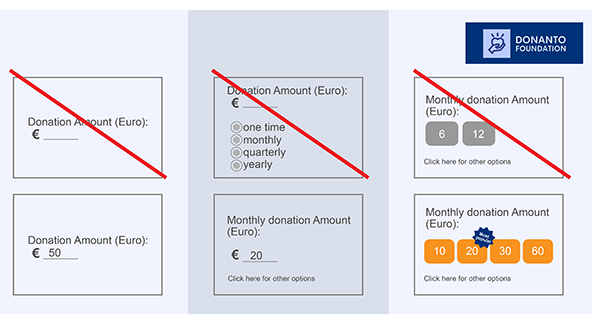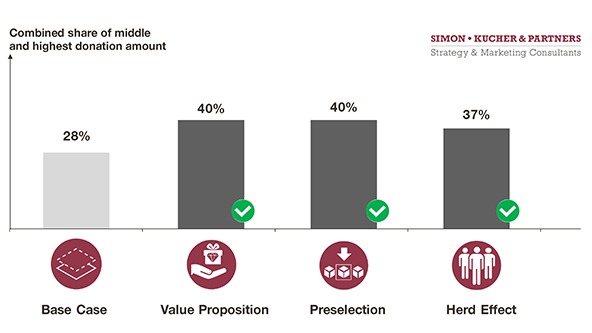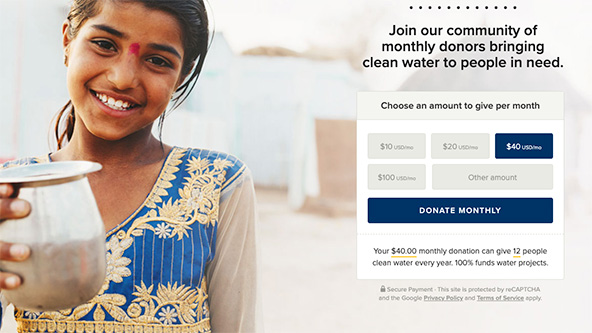Click here to read on Stanford Social Innovation Review.
By Fabian Farkas, Frank Bilstein, Florian Fleischer & Mehdi Damak
The holidays are nearly here, and many nonprofits will be depending on the year end for a boost in fundraising. Known as the “giving season,” November and December are the peak months for donating to charity, with the Charities Aid Foundation reporting that in 2018, 39 percent of people in the UK said they had donated in the last four weeks compared to an average of 32 percent across the year. Other research has found that as much as 20 percent of annual giving happens in December, with an especially high concentration in the last few days of the year.
When we think of the “giving season” it is easy to imagine scenes from old holiday movies. A volunteer dressed in festive attire stands in front of a shopping mall as passersby drop dollar bills into a donation bucket. However, in reality, a large share of donations received this year will not be in person at all. According to NonProfits Source, an SEO agency for nonprofits, six in 10 people will stop to talk to a fundraiser. In the digital world, a mere 0.08 percent of visitors to fundraising websites actually end up donating. So, when a visitor does reach the donation page, there is only a split-second opportunity for nonprofits to get things right.
Successful street fundraisers are engaging, motivational, and persuasive—quickly tuning into the emotional and cognitive needs of potential donors once they have caught their initial attention. Nonprofits need to recreate this experience in the digital world. But how?
Co-authors Frank Bilstein, from the Donanto Foundation, and Fabian Farkas, Florian Fleischer, and Mehdi Damak, from Simon-Kucher & Partners, conducted two separate studies, focusing on fundraising and nonprofits: A 2020 Online Fundraising Quick Wins Study by the Donanto Foundation, and the Behavioral Nudging Study by Simon-Kucher & Partners. Both point to behavioral economics as an answer, with the results of the Simon-Kucher study being revealed to the public for the first time in this article.
Shaping Online Donation Behavior
Behavioral economics research has shown people don’t always make the rational decisions we would expect. Instead, humans often act irrationally, with various social, cognitive, and emotional factors shaping decision-making. This topic is already covered extensively in literature, such as in Dan Ariely’s bestseller Predictably Irrational and Enrico Trevisan’s The Irrational Consumer.
The studies by Simon-Kucher and Donanto move the focus from economics to how behavioral nudges can be applied in the nonprofit world, and complement previous insights shared here at SSIR. Many nonprofits assume that a big uplift in donation amounts will require big efforts and investment. Rather, the two studies show that some nudges—small changes to how donations are presented—can make an outsized impact.
Filling in the Blanks
The Online Fundraising Quick Wins Study by Donanto highlights three key changes in how donations are elicited and their impact on fundraising income, using a base case where donors could enter freely the amount they wished to donate. The study then replaced this open field with several different options:
- Add an anchor to your online donation form: The study found that simply prefilling the donation field with an amount higher than your average donation amount can have an uplift effect of up to 20 percent.
- Emphasize recurring donations: Making monthly donations the default option and reducing accessibility of the “one-time donation” option can have an uplift effect of 20 to 50 percent. As expected, most of this uplift is driven by enticing donors to recurring donations. In one real-life application, the share of recurring donors jumped from 10 to 57 percent (while the number of donations increased as well). Our colleagues discussed additional ways to strengthen recurring revenues in a previous SSIR article.
- Give effective guidance: Presenting at least three (but no more than five) suggested monthly donation amounts is the most effective behavioral nudge in the study, with a donation uplift of more than 100 percent. Here the lowest suggested amount should be close to the most frequent recurring donation, the middle amount two or three thresholds above that, and the highest amount at least double the most frequent recurring donation.
(Chart courtesy of the Donanto Foundation)
Small Nudges, Bigger Numbers
With the study by Donanto having shown effective guidance to be the most powerful tool in achieving fundraising uplift, the team at Simon-Kucher looked more closely into different types of possible guidance. In the base case for the new Behavioral Nudging Study, potential donors were presented with three prefilled donation thresholds. Here, only 28 percent of donors chose to donate above the lowest suggested amount. This percentage was then improved in the study by applying additional nudges to deliver effective guidance:
- Highlight the value proposition: Donors are more willing to invest their time and resources if they have a clear understanding of how far their efforts will go. When given examples of what could be achieved with each donation amount (e.g., school books for 60 children, vaccinations for 90 children, clean water for 125 children), 40 percent of study participants chose to donate a higher amount than those that were not provided with the nudge (a 43 percent uplift). Building on the work already conducted by Donanto, the Simon-Kucher study showed that varying different examples of value propositions did not have a significant effect on donation amounts: what matters most is the fact that a clear value proposition is offered.
- Preselect a donation: Suggested donation levels send a signal about what is usual and expected. Similar to the Donanto study, in the Simon-Kucher study participants were presented with three options for donations that adhered to typical thresholds. However, in the Simon-Kucher study, when the middle option was preselected as the default, 40 percent of participants chose to donate a higher amount, compared to 28 percent in the base case with the same three thresholds but no preselection.
- Make use of the herd effect: People want to conform to social norms, especially when given credible proof of those normative behaviors. In the Simon-Kucher study, when participants were shown the average amount donated by other contributors in the same region, 37 percent chose to donate a higher amount.
(Chart courtesy of Simon-Kucher)
The Simon-Kucher study also explored other effects such as order effect (placing the highest donation amount first), but confirmed that providing guidance is the most effective tool for increasing donation income.
Behavioral Nudges: Naughty or Nice?
Nudges are interventions that can shape a donor’s intuition, remove barriers, and simplify actions. The question for each nonprofit is how to use them in a way that is both effective and perceived as fair. Donors should see their needs as being better accommodated, not exploited, and a successful nudge will be of value to both the nonprofit organization and the donors themselves.
In some cases, a clear value proposition with details of how fundraising money is spent will allow donors to make more informed decisions. In others, providing an anchor, showing the “standard” among peers, or preselecting a default amount can facilitate the decision-making process and alleviate some of the mental effort associated with donating.
A good example of these nudges at play can be found on the donation page of Charity Water. First, the value proposition is clear, informing donors that the default $40.00 monthly donation can give 12 people clean water every year. Moreover, the donation page presents multiple donation options at different thresholds, with the middle option pre-selected, while still allowing donors to enter their own suggested amount under “other amount.”
A screenshot from charitywater.org
Which nudges your donors will most value may depend on the unique nature of your own fundraising approach. One key takeaway for applying behavioral nudges to online fundraising is this: testing is crucial. Although behavioral economists would describe humans as “predictably irrational,” only through A/B testing can you know for sure what makes your target group tick. One multinational nonprofit supported by Donanto decided to combine its two donation buttons (“Donate” and “Become a member”) into one, only to find out that this supposedly improved clarity reduced the number of clicks to its donation forms by 40 percent!
A/B testing is relatively straightforward, but it is important to collect data based on a large enough sample size to draw proper (i.e., statistically significant) insights from the results. Nonprofits that rely on November and December for an increase in website traffic can use this period as a time to test out various nudges and then stick with the most successful ones in the new year. If you already have a significant number of visitors reaching your donation page today, the time to start is now.
Gathering these insights in advance will enable your nonprofit to capture the true magic of the holiday season!
Return to Insights & Events



